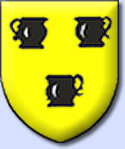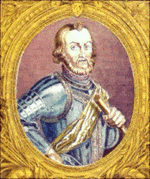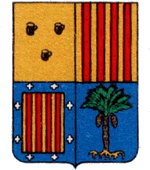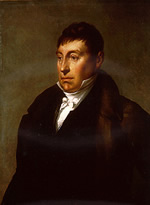 Or
three pignates
Or
three pignatesSable set 2-1.
Coat-of-Arms
 Or
three pignates
Or
three pignates
Sable set 2-1.
Historical
and illustrious family of southern Italy, recognized by many authors as descending
from the Lombard Dukes of Benevento, which proven line starts with Lucio Pignatelli,
Constable of Naples in 1102.
To
explain Coat-of-Arms and Name many authors refer that a famous Landolfo under
the service of King Roger of Hauteville of the Norman's Dynasty, during the
assault and the Sack of the Imperial Palace in Constantinople , he came out
holding on his hands three Silver Pignates and from then was assumed the Coat-of-Arms.
A
recent document found in the Archives of Monteroduni line stated that in 1094
two Pignatellis “orti a nobile sanguine
“ supplied over 1500 warriors to “ certamen
“ in the Holy land.
This
story will confirm that is most likely that the “Droit de Pillage “ was very
common at that time , thus the logic of the silver pignates ..
Other
Historians claim that a famous Gisulfo leading a fleet on behalf of the King
Roger of Hauteville against the Byzantines in Negroponte , won the naval battle
by launching pignates in fire.
The Family held numerous fiefdoms : Seigneur of
Caserta in 1269,
Patrician of Naples at the Seggi of Nido e Capuana.
Enjoyed
Nobility Rank in Rome , Venice , Sicily , Spain and Mexico.
The
family joined the Knights of Malta in 1420 with Giovanni , Commendatore of Monopoli
and Pietro Prior of Messina.
The
family held important positions in the Church Hierarchy and on Civil Service
.
The
family received the Toson d'Or in the branches of Monteleone and Terranova and Strongoli.
Grandee
of Spain in the Lines of Monteleone
e Terranova , Belmonte , Strongoli , Fuentes.
This
very Illustrious Family divided in three main Lines :
from RICCARDO in 1250 descended
TOMMASO , Governatore d'Atri ( 1431 ) and in the dawn of the XV Century three
main Lines were established by their sons
STEFANO ( branches of Marques of Casalnuovo , Princes
of Monteroduni , Dukes of Montecalvo )
CARLO
( Counts and Dukes of
Monteleone , Marques of Caronia ,Princes of Castelvetrano and through the last Heiress of Fernando Cortez
Marchioness of Valle Oaxaca
and Countess of Priego )
PALAMEDE
( Lords of Cerchiara ,
Princes of Noja, Princes of Holy Roman Empire , and through marriages
Dukes of Terranova , Princes
of Holy Roman Empire with the Branches of Belmonte ( 1723 ) ;Monteleone and Terranova , Strongoli ,Fuentes e Cerchiara
( 1648 )
The first-born line descending from CARLO(1421-1476)
extinguished with Geronima (1599- 1667 ) , Princess of Holy Roman Empire , V
Duchess of Monteleone , Countess of Borrello , Vice-Queen of Aragona in 1655
; daughter of Ettore III ,
IV Duca di Monteleone ( 1572 – 1622 ) , Viceroy of Catalogna and Caterina Caracciolo Countess of S. Angelo
dei Lombardi .
This Line ended in the Branch of Marchesi di Cerchiara and Principi di Noja
, with the marriage of Geronima with
Fabrizio Pignatelli , V Marchese of Cerchiara , III Principe of Noja , who inherited
from her the Dukedom of Monteleone (title held since 1527 ), the Earldom of Borrello (title held
since1520 ) and the Baronia of Mesiano e Rosario( titles held since 1501 ) and
the Earldom of S. Angelo di Lombardi via
Caracciolo family (title held since
1426 ).
Giacomo
Pignatelli (? – 1539 ) son of the third-born brother PALAMEDE started the Line of Cerchiara and Noja .
A very illustrious descendant of Giacomo was the Pontiff Innocenzo XII (
1691-1700 ), his secular name
was Antonio Pignatelli , son of Francesco dei Marchesi di Cerchiara, Marchese
di Spinazzola ( 1576 ) , Principe di Minervino in 1629, inheritance and succession
of the Carafa family, from his wife Porzia ( marr.1605) , daughter of Fabrizio
Carafa Duke of Andria .
The title of Marquis of Cerchiara was
granted in 1556 to Fabrizio I ( ? – 1567 ), son of Jacopo (Giacomo ) ; Viceroy
of Calabria , I Marquis di Cerchiara , II Signore di Noja.
The title of Prince of the Noja “State” (Basilicata/Lucania
) was granted in 1600 to Fabrizio ,
III Marchese di Cerchiara .
The first line of the Branch of Marchesi of Cerchiara and Principi di
Noja took also the name and the Coat-of-Arms of the family Aragona Cortes
, after the marriage attested in 1639 by the Notary P.Graffeo in Palermo.
In the contract , was established that all
descendants of Ettore Pignatelli , Marquis del Vaglio with Giovanna Tagliavia
Aragona Cortes, will carry the full Tagliavia Aragona Pignatelli Cortes name.
With this marriage the following fiefs and
titles were inherited : Marquis of Avola (title
held since 1542 ) ; Prince of Castelvetrano (title held since
1564 ) ; Duke of Terranova (title held since 1561) ; Count of Borghetto (
title held since 1565 ); the title Prince of the Holy Roman Empire was granted in
1648 ( with the right to all descendants m/f ) to the father of Giovanna : Diego Tagliavia Aragona Cortes
Duke of Terranova , Prince of Castelvetrano etc….
The above mentioned Giovanna , from her mother
Stefania Carrillo Cortes , niece of
Ferdinando Cortes, “ Conquistador del Mexico” inherited also the titles of Marquis of Valle Oaxaca and Count of
Priego ( Mexico ).
The name
Aragona , originated from Orlando Signore of Avola ( 1363 ) son of
King Federico II .
Tagliavia was a Sicilian family originated
by Bartolomeo , Signore of Castelvetrano ( 1209 ) and took the full name of Tagliavia Aragona with the marriage
of Giovanvincenzo Tagliavia , Count of Castelvetrano ( 1522 ) with Beatrice
Aragona niece of Federico III King of Sicily and Aragona .
In the XVII century with the marriage of
Nicolo’ Pignatelli ( bur. In Cerchiara
the 23rd of August 1648, bur. in Naples the 8th of
March 1730) : Viceroy of Sardinia
and Sicily , and second brother of Fabrizio III , V Marchese di Cerchiara e III Principe di Noja , with
her grand-niece Giovanna II Aragona
Pignatelli Cortes(1677-1723) daughter of Andrea Fabrizio (?-1677) Duke of Monteleone , all titles and fiefs
were inherited by the first-born of
the four brothers :
1- Diego , Prince of H.R.E. , Marquis of Valle Oaxaca later Duke
of Terranova and Monteleone.
2- Ferdinando, Prince of H.R.E. , later Prince of Strongoli
3- Antonio, Prince of H.R.E. , later
Count of Fuentes
4 -Fabrizio Prince of H.R.E. later Line of Cerchiara.
From the last born PALAMEDE
were generated the second
and third Line of Monteleone:
A} Princes of Strongoli (title held since 1620 ) : following the marriage of Ferdinando Pignatelli
, Prince of the Holy Roman Empire, Admiral
of the Kingdom of Naples , Grandee of Spain , Knight of Toson d’Or ,( 1689 – 1767 ) with
Lucrezia Pignatelli (1704 -1760) , IV Princess of Strongoli , VI Countess of Melissa and Duchess of Tolve, all titles
and fiefs inherited from the family Campitelli and Moles were received
through marriages.
B} The
Line Counts of Fuentes (Title held since
1508 ) inheritance and succession of the family Moncaio-Blanes
y Centelles.This branch had the honour to generate Saint Joseph Pignatelli (1737-1811)
, relevant representative of the Jesuit Order.
C} The Branch , descendant from Domenico Pignatelli Y de Vaez (1630 c.a.-1700
c.a. ) Marquis of S.Vincenzo, Capitano Generale of Estremadura ,Galicia and
Navarra , married Anna de Aymerich and
generated the following lines :
D} The Line Pignatelli y Americh
, Princes of Belmonte ( 1619 ) , Dukes of Acerenza ( 1593 ) , Marquis of Galatone
(1562 ) Counts of Copertino (1557 ) inheritance
from Ravaschieri and Pinelli family.
Paolina Francesca Pignatelli Y Americh- Pinelli-Ravaschieri Squarciafico
(1824-1911) (Female Succession) , direct
descendant of the above mentioned Domenico , she held the titles of XXI Countess
of Copertino , XI Marquise of Galatone , IX Duchess of Acerenza , VII Princess
of Belmonte etc.. Grandee of Spain on the Acerenza fief , daughter of Gennaro (1777-1829), she inherited
all fiefs ,estates and titles of brothers who died earlier; she married in 1839 Angelo V Granito,
IV Marquis of Castellabate and Baron
of Rocca Cilento, Gentiluomo di
Camera of H.M. the King of the Two Sicilies and Sovraintendente Generale of the Royal Archives.
E } and the Line Granito-Pignatelli di Belmonte originated.
The
descendants of STEFANO,
second-born of the famous above mentioned three brothers (XV century ) , generated
the Line of Marquis of Casalnuovo( 1630 ) , the Line of the Dukes of Montecalvo (1611) and the
actual first LINE of
Princes of Monteroduni (1702)
The line of Casalnuovo ended in mid of last
century
The Colonel of The House of Pignatelli today is :
Giovanni Pignatelli della Leonessa
(1920-) , VIII Prince of Monteroduni
, IV Prince of Sepino ,Count of Tuhegl
, Duke of Castoria ,Baron del Gallo , Patrizio Napolitano son
of the VII Prince of Monteroduni Luigi
(1885-1930) and Maria dei Marchesi Ajossa (1889-1969).
Following the Court Sentence of the Tribunal
of Naples in 1859 over the two centuries
old dispute , between the Casalnuovo line and the Monteleone-Terranova line,
concerning the title of Count of Borrello and Duke of Monteleone , titles granted to the Pignatelli branch by Ferdinand V of Aragon
with male primogeniture succession
; the above mentioned titles should have been used by the first male line ,
while the Pignatelli Tagliavia Aragona Cortes Line has always used the Monteleone
, Borrello titles through female succession according to the Spanish feudal
law of succession in force during the Spanish Vice-Kingdom of Naples:
Giovanna II daughter of Andrea Fabrizio last
Duke of Monteleone ( died in 1677 ) who married Nicolo’ Pignatelli Prince of
Noja and Marquis of Cerchiara and before with Geronima ( 1599-1667) who married
in 1615 Fabrizio V Marquis of Cerchiara and III Prince of Noja (see above and
Genealogy Tables and Pignatelli Cortes History )
Consequently the Monteroduni line , actual
first line, after the extinction of
Casalnuovo may hold the title of Count
of Casalnuovo , Count of Borrello , Duke of Monteleone.
Relevant Female Succession and Inheritance
into Pignatelli
Ruffo della Leonessa , Dukes of San Martino and Princes of Sepino ended
with Carolina (1814-1870) , who married Giovanni , Prince of Monteroduni bringing titles and estates and the name della
Leonessa.
Campitelli ,Princes of Strongoli and Counts of Melissa with
Giovanna , who married Geronimo Pignatelli in XVII Century.
Caracciolo , Counts of S.Angelo dei Lombardi with Caterina (1573-1622)
, who married Ettore Pignatelli , Count of Borrello and Duke of Monteleone.
Aymerich , Marquis of
San Vincenzo with Anna Giustiniana , who married in the XVII century, Domenico
Pignatelli Marquis of Cerchiara and Prince of Noja.
Tagliavia Aragona Cortes ,Princes of Castevetrano , Princes of H.R.E. ,
Marquis of Avola , Counts of Borghetto and Priego ,Dukes of Terranova , Marquis
of Valle Oaxaca (Cortes Line of Succession), Grandee of Spain with Giovanna
(1639) , who married Ettore Pignatelli , Duke of Monteleone and Count
of Borrello.
Pinelli-Ravaschieri , Princes of Belmonte , Marquis of Galatone , Counts
of Copertino , with Anna , who married in 1721 Antonio Pignatelli , Marquis of San Vincenzo.
Piccolomini , Princes of Valle and Maida , Dukes of Girifalco
and Lacconia , with Giulia who married in 1770 Ettore Pignatelli , XI Duke of
Monteleone.
Moncajo-Blanes Y Centelles , Counts of Fuentes with Maria Francesca , who
married in 1720 Antonio Pignatelli of the Marquis of Cerchiara and of the Princes
of Noja.
Gonzaga ,Dukes of Solferino , with Maria Luisa who in 1742
married Joaquim (Gioacchino ) Pignatelli
, I Count of Fuentes.
FIEFS and ESTATES held by The PIGNATELLI
family
The Fiefs were over 179
, we list here the relevant ones :
Amendolara , Bellizzi , Briatico
, Caiazzo , Castellamare sul Golfo , Carpineto , Ferolito , Ferrandina , Gallo
, Guastalla , Leverano , Maddaloni , Melfi , Novi , Nusco , Orta , Palma , Pisciotta
, Regina , Sant’Angelo , Sant’Eufemia , Scafati , Summonte , Taurasi , Torritto
, Tufara , Trecase , Veglie …
Earldoms
18 :
Counts of Acerra , Borghetto
(1564 ) , Borrello ( 1506 ) , Cerinola , Cerignola , Copertino ( 1557 ) , Egmont
, Fuentes , Melissa , Mesagne , Montavano , Monteleone , Priego , San Giovanni
Lappione (1618 ) , Sant’ Angelo de’ Lombardi ( 1508 ) , San Valentino , Tuehgl
, Vaglio.
Marquisates
22 :
Argensola , Avola , Caronia
, Casalnuovo (1630 ) , Cerchiara ( 1556 ) , Collelongo ( 1735 ) , Colletorto
( 1712 ) , Favara (1559 ) , Galatone ( 1562 ) , Lauro , Moio , Padula , Paglieta
,( 1603 ) , Sambuca , San Giovanni , San Vincenzo , Spinazzola ( 1586 ) , Tertiveri
, Trentola , Tufara , Vaglios , Valle Oaxaca ( 1547 ) with the Signorie in Mexico
of ( Caro , Cotaxilla , Coyocan , Cuernavaca , Etla , Nico , Sancta Maria ,
Sant’Anna , Tambaya , Tapulia , Tuxilla ).
Dukedoms
17 :
Acerenza ( 1593 ) , Alliste
, Bellosguardo , Bisaccia ( 1600 ) , Caivano ,Castoria (1715), Corigliano d’Otranto
( 1798 ) , Girifalco , Montecalvo (
1611 ) , Monteleone ( 1533 ) , Rocca Mondolfa , San
Demetrio ( 1735 ) , San Marco , San Martino (1621 ) , San Mauro , Terranova ( 1561 ) ,
Tolve ( 1678 ) .
Princes
14 :
Belmonte ( 1619 ) , Castelvetrano ( 1564 ) , Marsiconuovo ( 1677 ) , Minervino ( 1631 ) , Moliterno ( 1745 ) , Monasterace , Montecorvino ( 1750 ) , Monteroduni ( 1702 ) , Muro Leccese ( 1798 ) , Noja ( 1600 ) , Racale , Supino ( 1627 ) , Valle and Maida
 Genealogy Cortes Pignatelli Genealogia Cortes Pignatelli Click Here |
 History Pignatelli Aragona Cortes Click Here |
 Lafayette-Pignatelli Line |
|
The Dynastic Tradition of the Pignatelli family
The Pignatelli Family traced their ancestry back to Agilmondo , a King of Lombards (VIII-IX) Century , of the Dukedom and later Principality of Benevento. It was and it is a proud and illustrious family. It was one of the seventh great families of the Realm (of Naples). It was also very common to marry with other prominent families, (including the other Pignatelli Branches ), as a way to keep and inherit the assets ,the fortunes and to hold power and wealth. Pignatelli
married into Carafa , Sanseverino , Caracciolo , d'Aquino ,del Balzo, But in many ways the Neapolitan families as Carafa and Pignatelli (Papal families) were unlike other roman papal families ( the power and wealth was within Rome and Lazio region ) : the base of power and the source of their wealth were the feudal holdings in the Kingdom of Naples and Sicily. Their policy tended to marry the heiress of Principalities and fiefdoms of Southern Italy. We outline some interesting examples: Niccolo
Pignatelli V Prince of Noja married in 1679 Giovanna Pignatelli Ettore IV Duc of Monteleone married in 1592 Caterina Caracciolo heiress of the Earldom of S.Angelo de' Lombardi. (fief between Salerno and Bari) Ferdinando
Pignatelli Knight of the Toson d'Or , Prince of the Holy Roman Empire
, Duke of Tolve , Grandee of Spain , married in 1719 In the Genealogy section , we can see the complex marriage policy implemented by the family. At the peak of their power the Pignatelli were owners of 179 fiefs , 18 Counties or/Earldom , 22 Marquisates , 16 Dukedoms and 14 Principalities . Today
several branches are still existing. |
|
Historical Notes on
Neapolitan Nobility and Aristocracy
They differed in structure, wealth and power. After the unification of Italy previous Nobility laws and customs were maintained. Historically, since the introduction of the Feudal System,Titles were granted by Emperors ,Kings(German,Austrian,French,Spanish) and Popes,in addition Powerful Lords (Milan Dukes, Tuscany ,Venice,Parma...) also conceded Titles To local Aristocracy. The hereditary Titles of Principe,Duca,Marchese,Conte,Barone were granted by Patent Letter by Emperors,Popes and Kings out of the Feudal System of the Holy Roman Empire. The Status of Patrizio is related to the City of origin. The Title of Don means Noble Rank and The Consulta Araldica(Italian authority after the unification ,which supervised the Titles recognition and concession) in 1929 granted this historical custom (Don and Donna) only to those Feudal Families(mainly Naples and Sicily) of Princes ,Dukes , the Roman Nobility and some Lombard Families. When the Italian Republic was established in 1946,all Titles were abolished, but the Noble Families recognized before 1928, were authorized to incorporate the title on the surname. Naples (Dukedom then Realm) All
Conquerors of Southern Italy adopted the Feudal System, Land possession
was divided in Fiefs since the Lombard invasion in 590-839 AD (the first
Dukedom was established in Benevento in 758 AD).
Under the Angevins (1262-1441) and Aragonese(1442-1495) ruling not changements were made. With the Emperor Charles V (Spanish Ruling 1503) the system was modified as the last descendant died ,remote and collateral lines must succeed male and/or female. During the Reign of Philip II of Spain (1595) and Charles VI of Austria( 1720) was introduced the Male succession in spite of Female with equal right. The
titles of Princes and Dukes were granted outside the Royal Family already
under the Angevins and Aragonese ruling (Queen Jeanne I 1343 and Alfonso
the Magnanimous 1442): Prince of Taranto (1373) to Giacomo del Balzo; Under the Spanish Viceroyalty and ruling (1504-1707) titles were distributed lavishly. With the arrival of The Bourbons (1740-1799 and the restoration 1805-1861) the practice of a husband to adopt the title of the woman was officially legitimate. The titles of Prince in the Royal Family were allowed only to primogeniture of Males. During
the Napoleon Ruling (1799-1815) the Feudalism was officially abolished
by Joseph Bonaparte (1806), but all titles granted were confirmed |
|
Essential Chronology of the History of Naples
They were formed
into the Kingdom of Sicily, with its capital at Palermo, under Count Roger
II of Sicily (1130). Under the Angevins, and thereafter, the mainland is known as 'Sicilia citra Farum' (i.e., Sicily on this side of the lighthouse marking the straits of Messina), but comes often to be called the Kingdom of Naples; the island of Sicily is known as 'Sicilia ultra Farum' (beyond the lighthouse). The revolt known as the Sicilian Vespers (1282) separated the island from the mainland and placed it under Aragonese rule; after the conquest of Naples by Alfonso of Aragon (1435-42) the island and the mainland came again under a single ruler, but on Alfonso's death (1458) they were again separated; the conquest of Naples by Ferdinand of Aragon (1501-04) once more placed them under a single ruler, but administrative union in the form of the 'Kingdom of the Two Sicilies' was not carried through until 1816. The Normans
1189-1197
Emperor Henry VI claims the Sicilian throne in the right of his wife;
he is opposed by Tancred of Lecce (d. 1194)
1266-1285
Charles I
|
To be continued….By Gioacchino del Balzo copyright 2001